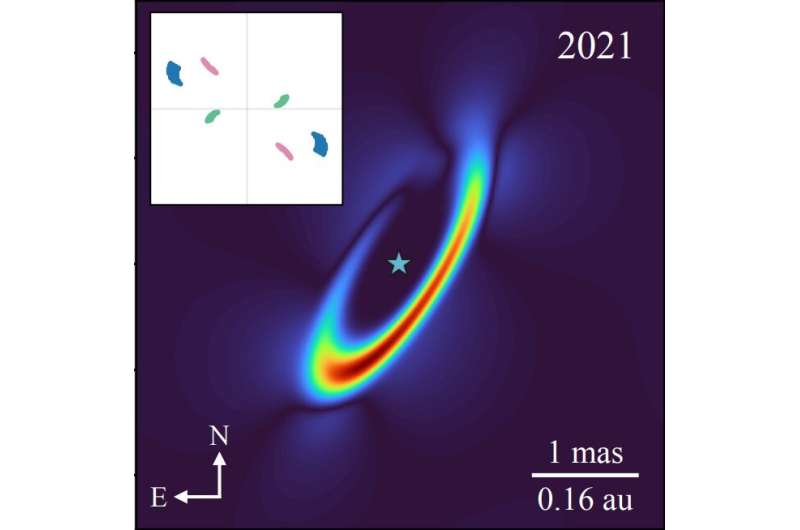Model image of CI Tau's inner disk in 2021. Credit: Soulain et al, 2023
Using ESO's Very Large Telescope (VLT), an international team of astronomers has probed the inner dusty ring of a young star known as CI Tauri (or CI Tau for short). Results of the study, published May 14 on the arXiv pre-print server, deliver important insights into the properties of this disk.
CI Tau is a classical T Tauri star located some 522.6 light years away in the Taurus molecular cloud. It is approximately two times larger than the sun, has a mass of about 0.9 solar masses and is estimated to be two million years old. Previous studies of CI Tau have found that it is orbited by at least one planet—a hot super-Jupiter that is approximately 11.3 times more massive than Jupiter.
Observations of CI Tau have also detected a circumstellar disk that extends up to 200 AU on millimeter continuum images, with gaps located at radii of 13, 39, and 100 AU from the star, suggestive of on-going planet formation. The star is still accreting material from a debris disk at an unsteady pace, possibly modulated by the eccentric orbital motion of its planet.
A group of astronomers led by Anthony Soulain of the University of Grenoble in France, decided to observe the CI Tau system using the Very Large Telescope Interferometer (VLTI) in order to shed more light on the properties of the dusty inner disk.
"We aim at spatially and spectrally resolving the innermost scale (≤ 1 au) of the young stellar system CI Tau to constrain the inner disk properties and better understand the magnetospheric accretion phenomenon," the researchers wrote in the paper.
The observations identified a highly inclined resolved inner disk, whose inner edge is located at a distance of about 21 times the radius of CI Tau from the star. The measured inner rim position appears to be significantly farther than the theoretical sublimation radius. This, according to the astronomers, means that a close-in massive planetary companion may be present in the system.
It was found that the inner disk of CI Tau showcases a strong misalignment relative to the outer disk seen at submillimeter wavelengths. The researchers suppose that such a misalignment could be induced by magnetic warping or by gravitational torques induced by a close-in massive companion.
The results also allowed Soulain's team to shed more light on the magnetospheric accretion region of CI Tau. The size of the Brackett-gamma emitting region was found to be consistent with the magnetospheric accretion process. However, the size of this region turned out to be significantly smaller than the co-rotation radius. The authors of the paper concluded that this leads to an unstable accretion regime, presumably at the origin of the stochastic photometric variability of the system.
More information: A. Soulain et al, The GRAVITY young stellar object survey—XI. Probing the inner disk and magnetospheric accretion region of CI Tau, arXiv (2023). DOI: 10.48550/arxiv.2305.08170
Journal information: arXiv
© 2023 Science X Network
























